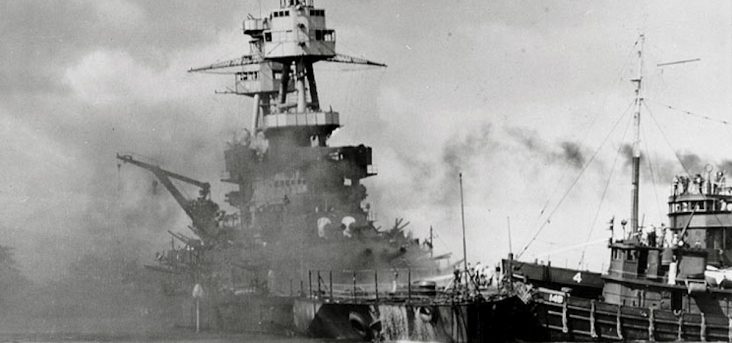An historic Navy vessel to soon arrive in North Little Rock, will help ‘bookend’ World War II naval history
by November 20, 2015 5:03 pm 1,062 views

In this photo, the USS Hoga (right) is pushing the burning USS Nevada out of the primary channel at Pearl Harbor during the Dec. 7, 1941, surprise Japanese attack. The Hoga is now being towed to the Arkansas Inland Maritime Museum in North Little Rock.
Slowly on its way up the Mississippi River, heading toward North Little Rock is the USS Hoga, a United States Navy, Woban-class district harbor tugboat that’s been the subject of World War II history, a Naval lawsuit, a potential Jones Act violation, and more than a few jokes in central Arkansas.
“When the Hoga arrives, North Little Rock will be the only place in the continental United States with vessels that bookend World War II,” said John Gill, board member for the Arkansas Inland Maritime Museum and Commissioner for the Arkansas State Parks, Recreation and Travel Commission.
The Hoga will be one of two boats at the Arkansas Inland Maritime Museum. The submarine USS Razorback is available for tours at the museum, located in North Shore Riverwalk Park along the shore of the Arkansas River. The Razorback was part of the U.S. fleet at Tokyo Bay when Japan surrendered. The Hoga was in Pearl Harbor December 7, 1941, when it was attacked by Japanese forces. It fought fires on the USS Arizona and pushed the USS Nevada out of the channel, which is what allowed the Harbor to stay operational in the early months of World War II.
The Hoga – a Native American word for “fish” – was transferred from Pearl Harbor to the Port of Oakland after World War II. It was declared a National Landmark in 1989. For many years after it was decommissioned, the Navy struggled to figure out what to do with it. In 2005, Mayor Pat Hayes and the North Little Rock City Council won a bid to have it moved to central Arkansas with plans to open the maritime museum. They were also able to secure The Razorback – which was being cycled out of the Turkish Navy – around that time for the museum.
“Getting the Hoga from San Francisco turned out to be harder than getting the Razorback from Turkey,” said Stan Hastings, a board member of the Arkansas Inland Maritime Museum.
Someone sued the Navy over the Hoga selection process. By the time that was resolved, the cranes that could be used to lift the boat onto a transportation ship had left the area because of decline in ship building in the area. The tugboat had to be towed to San Diego, then on to Mexico to get to a crane that could lift it onto a ship that usually delivers yachts. That ship came through the Panama Canal around to the Port of New Orleans, where it was rejected. Homeland Security cited the Jones Act that anything coming from one U.S. Port to another U.S. port must be on a U.S. flagged ship. The yacht ship is flagged for Mexico. Since the boat had been in San Diego, there was confusion about the original point of origin. The ship went on to the Port of Houston, where they were able to sort out the issue and now the Hoga is being towed up the Mississippi.
“Somewhere in all that, a decade went by,” said Gill.
The museum opened with exhibits on the battleship USS Arkansas (BB-33), and the missile cruiser USS Arkansas (CGN-41). In addition are two memorials dedicated to submarines USS Snook (SS-279) and USS Scorpion (SSN-589). The Razorback arrived in North Little Rock, was restored, and opened to the public. More than 300,000 people have taken tours.
Now officials are excited to welcome the Hoga to what more than a few people have jokingly referred to as “Hays Navy” – a reference to former North Little Rock Mayor Patrick Hays. While it might have originally been a punch line, Hastings said he thinks the number of tourists who have come through have been vindication that the museum turned out to be exactly what people had hoped it would be: historical preservation and a tourism draw.
“Pearl Harbor would love to have those vessels,” Hastings said. “The reason they’re in North Little Rock is because of fresh water. The Navy realized that coastal preservation is almost impossible and very expensive. The salt water just eats those boats up. By getting them to Arkansas, they’ll outlive me.”
Because they are relying on donated towing services, officials don’t have a firm date when to expect the Hoga. It should arrive sometime late in the week of Thanksgiving or the first week of December. Once in North Little Rock, the Hoga will be evaluated to see what restoration work it needs. There is no timeline for when it will be open for viewing by the public.
Anticipating the Hoga will be tied up in port by then, the state has moved its annual commemoration of Pearl Harbor Day to the museum at 2 p.m. Dec. 7.
